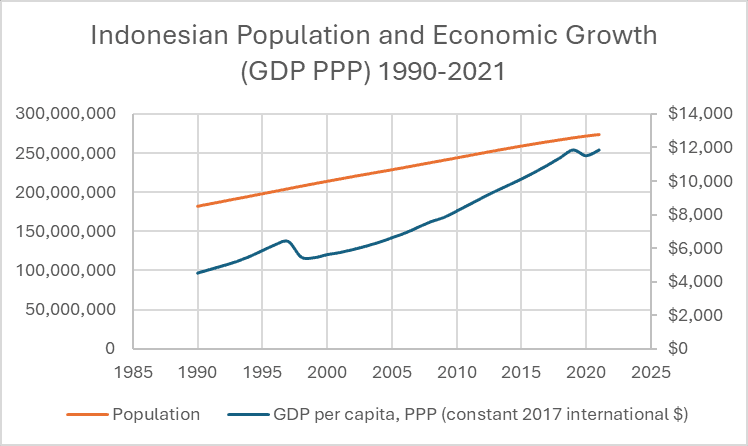Abstract
In two discussion papers, we analyse the increasing importance of the superpower rivalry between China and the United States at regional and international levels, especially in the context of two emerging economies: Indonesia and Japan. With reference to theoretical foundations, we address different scholarly and policy perspectives and propose novel ways of conceptualising power that can help us to better understand regional and global geopolitical conflict. At the centre of the evolving regional and global order, each of our examined countries plays a crucial role in shaping regional and global affairs.
Indonesia: An emerging archipelago
By Arseny Biryukov
Indonesia’s continuing rise to prominence in southeast Asia generates waves that disrupt the status quo. Its status as a former colony affords the country significant economic and military ties with the West, weathering the powerful regional force exerted by China through economic and soft power policies, such as the Belt and Road Initiative (BRI). In harnessing its demographic, geographic, and economic peculiarities, Indonesia will serve as a neutral balancer – in the words of president Joko Widodo: a “global maritime fulcrum” – that mitigates the regional impact of the global conflict between Washington and Beijing (Laksmana, 2019).
Indonesia’s context
In its recent history, Indonesia has transformed itself from a struggling authoritarian post-colonial state to the world’s third-largest democracy. After the Second World War, Indonesia was controlled by a military dictatorship characterised by civil and political repression, and it wasn’t until 1999 that the country held free elections. As a nascent democracy, Indonesia has faced significant growing pains through corruption and electoral fraud. Many of Indonesia’s ruling political elites held power during its authoritarian government, yielding a particularly difficult democratic transition. Indeed, Prabowo Subianto, one of the leading candidates in Indonesia’s recent presidential election, is a former special forces commander with a chequered human rights record and close ties to the late dictator Suharto.
Indonesia’s historical backdrop renders its growth all the more impressive, from its meteoric economic rise as the world’s 7th-largest economy, to its similar demographic rise, more than doubling in population from 118 million in 1971 to almost 280 million today (Database Earth, 2024). Such accomplishments go hand-in-hand: as Indonesia’s population has grown, so has its workforce and consumer base.
As an emerging economy, as identified by the International Monetary Fund, Indonesia has forged close ties with its regional neighbours, most prominently through the Association of Southeast Asian Nations (ASEAN). Founded in 1967, ASEAN is one of the largest and most diverse supranational organisations in Asia, spanning over 650 million people and a combined GDP of over $3.5 trillion (Council on Foreign Relations, 2024; Biswas, 2024).

Figure 1: A graph demonstrating Indonesia’s rise in population and GDP purchasing power parity from 1990 to 2021. The upward trends are indicative of an emerging country, and these statistics set conditions for a more influential Indonesia (data source: Our World in Data).
Navigating the tightrope between China and the United States
Such regional ties are particularly important given Indonesia’s location adjacent to the South China Sea, a critical artery of the contemporary global economy, especially through the Strait of Malacca. The trade has also contributed to Indonesia’s prosperity, and Indonesia has invited China to several billions of dollars’ worth of investment through the BRI (Asmarini and Jefriando, 2019). Yet, China’s claims of sovereignty over the sea and its natural reserves have both antagonised Indonesia (Center for Preventative Action, 2024), a country also wary of how a decline in China’s economy could reverberate on its own. Indonesia thus considers China a somewhat volatile partner.
China’s aggressive foreign policy pulls other countries into its sphere of influence. As Russel and Berger (2020) reflect on the BRI: “The trend is toward an increasingly Chinese-dominated political, economic, technological, and strategic ecosystem in the Indo-Pacific. The challenge … [is] Beijing’s enhanced ability to project its sovereignty, rules, or undue influence based on a unilateral assertion of core interests … [which compromises] America’s ability to safeguard [the existing] order and maintain regional peace and stability.” Such a concern has similarly alarmed Japan, who have responded with inconsistent foreign policy across its administrations.
Despite its ties to China, Indonesia’s military has been engaged in a “comprehensive strategic partnership” with the American military, for example through joint exercises in the Garuda Shield training exercise. These exercises are intended to strengthen interoperability, capability, trust, and cooperation in support of a free and open Indo-Pacific (Da Costa, 2023). Thus, there exists a dynamic of powerful competing interests in Indonesia, a nation identified by both China and the United States as an important player in their rivalry. From the perspective of the United States, Indonesia could be the key to containing China, for example through its chokepoints into the South China Sea and its developing military power. From China’s perspective, Indonesia is a brother country: the largest Chinese diaspora community lives in Indonesia, numbering more than 10 million people (Statista, 2022), many of whom are descended from migrants born in China many generations ago.
What is striking about the US and China’s relationship to Indonesia is the soft power China exerts over Indonesia. Soft power is described as that “less transferable, less cooperative, and less tangible” kind of influence (Nye, 1990). Whereas, the United States’ relationship has more overtly used hard power (for example through military exercises). Yet, China’s efforts have paid off: Santo Darmosumarto, Director of East Asia and Pacific Affairs at Indonesia’s Ministry of Foreign Affairs, said in 2023 that Indonesia “would stay neutral” in a conflict over Taiwan (Perlez et al., 2023). Nonetheless, the United States still has options to address Indonesia, by “highlight[ing] – discreetly and respectfully – how China may be eroding Indonesian autonomy through its coercive behaviour,” (Grossman, 2021).
Manifest and latent power
Having evaluated Indonesia’s history and context, one distinction arises that could help to understand its current situation: the difference between manifest and latent power. Manifest power can be thought to encompass the combination of immediate soft, hard, smart, structural, etc., power that a country can bring to bear on present issues. Latent power, on the other hand, can be considered the sum of power that a country would be able to wield considering long-term trends and more subtle variables that influence international relations. Indonesia’s manifest power is and has historically been relatively weak despite the country’s size: it does not immediately have any obvious resources that give it leverage, nor is its military capability particularly significant. So, China and the United States have invested time and effort into influencing Indonesia because of its immense latent power. A country with so large a population, in a geographical position to take advantage of billions of dollars of trade, would be an immense boon because these latent factors will gradually yet surely evolve into manifest power. Viewing the topic of Indonesia’s role within the international system through the novel lens of manifest and latent power helps to build a more comprehensive framework to address the various complexities that make themselves apparent.
Indonesia has focussed on non-alignment and neutrality in a world order of ever-increasing conflict. As tensions grow, the country walks a dangerous tightrope to maintain this policy.
Japan: An island in choppy geopolitical waters
By Jiwon Chung
The global geopolitical landscape has undergone significant transformations, marked by the emergence of new power dynamics and the reconfiguration of longstanding alliances. At the centre of this evolving landscape are the United States, China, and Japan, each playing crucial roles in shaping regional and global affairs. Scholars have offered diverse perspectives on the complex interplay between these major powers, considering historical legacies, economic interdependencies, and strategic calculations. This essay synthesises revelations from various papers to offer some insights into the geopolitical dynamics of East Asia and beyond.
In a paper for the European Consortium for Political Research, Pugliese writes: “Japan is perhaps the third party with the biggest stake in the structural change centred upon US relative decline and China’s rapid rise,” (Pugliese, 2012). Thus, Pugliese underscores the nuanced approach that Japan must adopt to effectively navigate its relationship with major powers. Yet, the declinist narrative may be challenged by the ways in which the United States has effectively renewed its capitalist model in East Asian states, thereby strengthening the United States’ strategy in East Asia (Parisot, 2012).
Japan’s strategic position in East Asia is characterised by the delicate balancing act between its alliance with the United States and its burgeoning economic relationship with China. Japan’s leaders, including their idiosyncratic tendencies and styles of leadership, have significantly shaped foreign policy in unique directions (Yoshimatsu, 2012): the foreign policy of the administrations of Shinzo Abe, Yasuo Fukuda, Tarō Asō, and Yukio Hatoyama each reflected different world perspectives and foreign policy objectives. If Abe prioritised the strengthening of Japan’s security alliance with the United States, Fukuda adopted a more conciliatory approach towards China, centred on economic cooperation and diplomatic dialogue. Asō’s administration sought more of a compromise between these two, with limited success, whereas Hatoyama’s vision of an “East Asian Community” emphasised regional cooperation while maintaining the security alliance. Despite these differences, the overarching aim of Japan’s foreign policy is to safeguard its security interests while maximising regional economic opportunities.
A neoclassical realist perspective may lead us to evaluate the relationship between China and the United States in terms of systemic variables that constrain their interactions (Ripsman, 2011). Particular thought can be given to how domestic priorities and interactions influence a state’s foreign policy choices (Foulon, 2012). However, a multifaceted approach can synthesise insights from different scholarly traditions, better grasping the dynamics shaping the future of global politics. At the same time, the importance of China in the evolving nature of global affairs must be considered in its proper context, rather than oversimplifying or exaggerating its importance. From a historical perspective, the way in which Western pressure on China has increased in light of its changing economic structure and growing awareness of human rights violations should also be considered (Brands and Beckley, 2021).
The discussion highlights how Indonesia and Japan have navigated the tension between China and the United States in different ways. While Indonesia has been willing to walk the tightrope of tension in favour of its domestic interests, Japan’s foreign policy has shown signs of inconsistency across administrations. The United States has continued to exert important systemic regional economic influence, and predictions of its long-term decline may be premature or overly pessimistic. Different theoretical schools in international relations can help us to better understand the differences between the approaches of Japan and Indonesia, both on a descriptive and prescriptive level.
Conclusion
Our discussion papers have considered how the rivalry between China and the United States has affected two emerging economies: Indonesia and Japan. Through proposing a distinction between manifest and latent power, we have considered how Indonesia’s policy of navigating the tightrope between China and the United States can explain its foreign policy. These papers have also highlighted Japan’s inconsistent approach, partly as an older emerging economy, as well as the evidence Japan provides for the role the United States can play through economic ties. Each of our examined countries plays a crucial role in shaping regional and global affairs, and it remains to be written how they will navigate the geopolitical evolution of regional and global bipolarity in international relations.
Bibliography
Asmarini, Wilda, and Jefriando, Maikel (2019). Indonesia Asks China for Special Fund under Belt and Road – Ministers. Reuters, 3 July 2019. URL: https://www.reuters.com/article/idUSKCN1TY1EH/ (accessed on 8 March 2024).
Biswas, Rajiv (2024). ASEAN Economic Outlook in 2024. S&P Global Market Intelligence, 12 January 2024. URL: https://www.spglobal.com/marketintelligence/en/mi/research-analysis/asean-economic-outlook-in-2024-jan24.html (accessed on 8 March 2024).
Brands, Hal, and Beckley, Michael (2021). China Is a Declining Power — and That’s the Problem. Foreign Policy, 24 Septeber 2021. URL: https://foreignpolicy.com/2021/09/24/china-great-power-united-states/ (accessed on 8 March 2024).
Center for Preventative Action (2024). Territorial Disputes in the South China Sea. URL: https://www.cfr.org/global-conflict-tracker/conflict/territorial-disputes-south-china-sea (accessed on 8 March 2024).
Council on Foreign Relations (2024). What Is ASEAN? URL: https://www.cfr.org/backgrounder/what-asean (accessed on 8 March 2024).
Da Costa, Gusty (2023). Garuda Shield: A ‘Super’ Exercise Transcends Growing Regional, Global Security Concerns. Indo-Pacific Defense Forum, 6 March 2023. URL: https://ipdefenseforum.com/2023/03/garuda-shield (accessed on 8 March 2024).
Database Earth (2024). Population of Indonesia. URL: https://database.earth/population/indonesia (accessed on 8 March 2024).
Foulon, Michael (2012). Neo-classical Realist and Innenpolitik Perspectives on the Changing Position of the US, and its Relationship with China, in Contemporary Global Politics. ECPR Graduate Student Conference Bremen, 4–6 July 2012. URL: https://ecpr.eu/Events/Event/PaperDetails/227 (accessed on 8 March 2024).
Grossman, Derek (2021). Indonesia Is Quietly Warming Up to China. Foreign Affairs, 7 June 2021. URL: https://foreignpolicy.com/2021/06/07/indonesia-china-jokowi-natuna-sea-military-bri-cooperation-biden-united-states/ (accessed on 8 March 2024).
Laksmana, Evan (2019). Indonesia as “Global Maritime Fulcrum”: A Post-Mortem Analysis. Asia Maritime Transparency Initiative, 8 November 2019. URL: https://amti.csis.org/indonesia-as-global-maritime-fulcrum-a-post-mortem-analysis/ (accessed on 8 March 2024).
Nye Jr, Joseph S. (1990). Soft Power. Foreign Policy, No. 80 (Twentieth Anniversary: Autumn, 1990). pp. 153–171.
Parisot, James (2012). East Asia in the American Empire of Capital. ECPR Graduate Student Conference Bremen, 4–6 July 2012. URL: https://ecpr.eu/Events/Event/PaperDetails/228 (accessed on 8 March 2024).
Perlez, Janes, Schmitt, Eric, and Wee, Sui-Lee (2023). China and the US are Wooing Indonesia, and Beijing Has the Edge. New York Times, 1 February 2023. URL: https://www.nytimes.com/2023/02/01/world/asia/indonesia-china-united-states.html (accessed on 8 March 2024).
Pugliese, Giulio (2012). Between a rock and a hard place? Japan’s Government Policy towards the US and the PRC. ECPR Graduate Student Conference Bremen, 4–6 July 2012. URL: https://ecpr.eu/Events/Event/PaperDetails/226 (accessed on 8 March 2024).
Ripsman, Norrin M. (2011). Neoclassical Realism. Oxford Research Encyclopedias. URL: https://oxfordre.com/internationalstudies/display/10.1093/acrefore/9780190846626.001.0001/acrefore-9780190846626-e-36 (accessed on 8 March 2024).
Russel, Daniel R., and Berger, Blake H. (2020). Weaponizing the Belt and Road Initiative. Asia Society Policy Institute. URL: https://asiasociety.org/sites/default/files/2020-09/Weaponizing%20the%20Belt%20and%20Road%20Initiative_0.pdf (accessed on 8 March 2024).
Statista (2022). Selected Countries with the Largest Number of Overseas Chinese 2022. URL: www.statista.com/statistics/279530/countries-with-the-largest-number-of-overseas-chinese/ (accessed on 8 March 2024).
Yoshimatsu, Hidetaka (2012). Japan’s China Policy in Domestic Power Transition and Alliance Politics. Asian Affairs: An American Review. Vol 39, No. 2 (April–June 2012). pp. 106–126.




